Australia’s threatened species plan has failed on several counts. Without change, more extinctions are assured
- Written by Euan Ritchie, Professor in Wildlife Ecology and Conservation, Centre for Integrative Ecology, School of Life & Environmental Sciences, Deakin University
Australia is globally renowned for its abysmal conservation record[1] – in roughly 230 years we’ve overseen the extinction of more mammal species than any other nation. The federal government’s Threatened Species Strategy[2] was meant to address this confronting situation.
The final report[3] on the five-year strategy has just been published. In it, Threatened Species Commissioner Dr Sally Box acknowledges while the plan had some important wins, it fell short in several areas, writing:
…there is much more work to do to ensure our native plants and animals thrive into the future, and this will require an ongoing collective effort.
Clearly, Australia must urgently chart a course towards better environmental and biodiversity outcomes. That means reflecting honestly on our successes and failures so far.
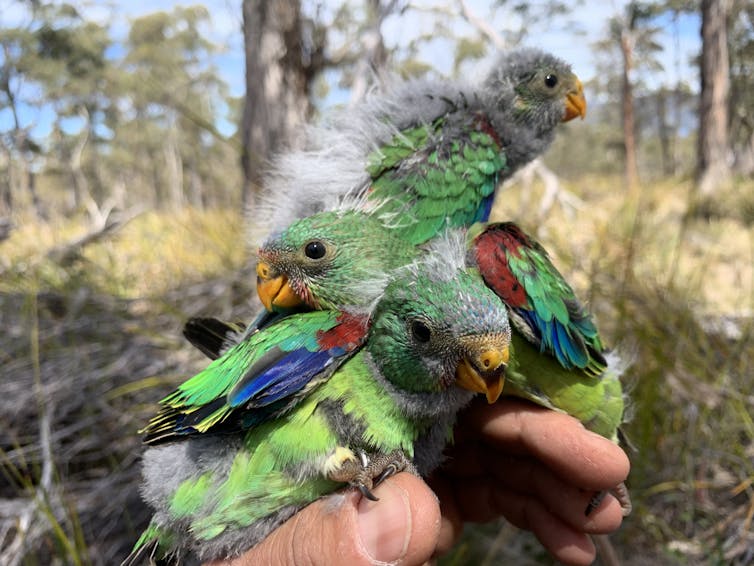 The Threatened Species Strategy must be strengthened to save critically endangered species such as the swift parrot from extinction.
Dejan Stojanovic, Author provided (no reuse)
The Threatened Species Strategy must be strengthened to save critically endangered species such as the swift parrot from extinction.
Dejan Stojanovic, Author provided (no reuse)
How did the strategy perform?
The strategy, announced in 2015, set 13 targets linked to three focus areas:
- feral cat management
- improving the population trajectories of 20 mammal, 21 bird and 30 plant species
- improving practices to recover threatened species populations.
Given the scale of the problem, five years was never enough time to turn things around. Indeed, as the chart below shows, the report card indicates five “red lights” (targets not met) and three “orange lights” (targets only partially met). It gave just five “green lights” for targets met.
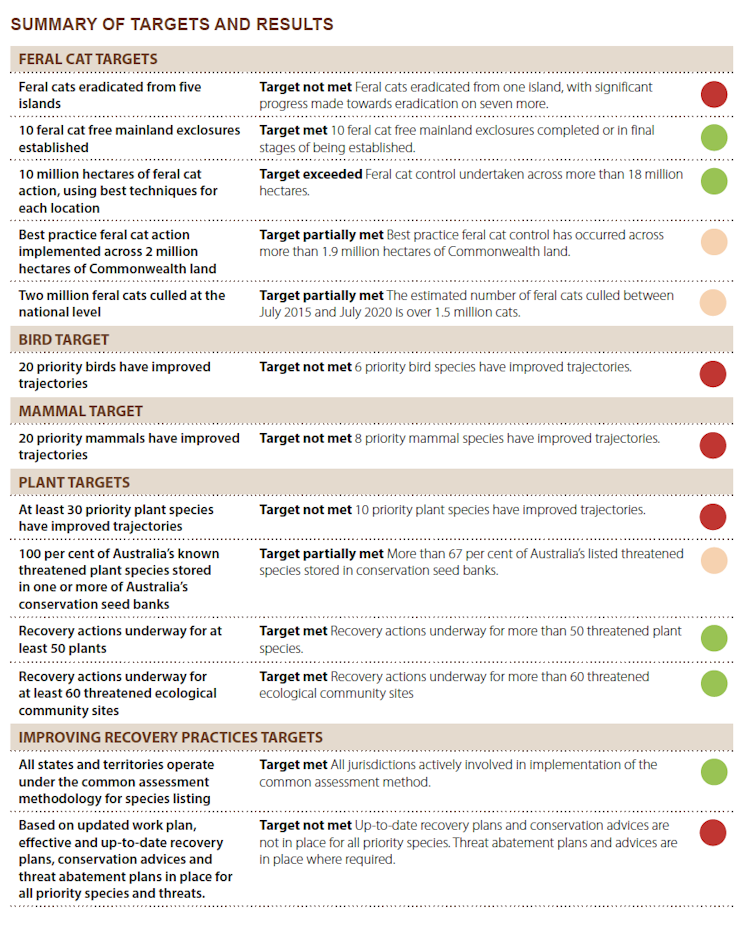 Summary of the Threatened Species Strategy’s targets and outcomes.
Department of Agriculture, Water and the Environment
Summary of the Threatened Species Strategy’s targets and outcomes.
Department of Agriculture, Water and the Environment
Falling short on feral cats
Feral cats were arguably the most prominent focus of the strategy, despite other threats[4] requiring as much or more attention, such as habitat destruction via land clearing[5].
However, the strategy did help start a national conversation about the damage cats wreak on wildlife and ecosystems[6], and how this can be better managed[7].
In the five years to the end of 2020, an estimated 1.5 million feral cats were killed under the strategy – 500,000 short of the 2 million goal[8]. But this estimate is uncertain due to a lack of systematic data[9] collection. In particular, the number of cats culled by farmers, amateur hunters and shooters is under-reported. And more broadly, information is scattered across local councils, non-government conservation agencies and other sources[10].
Read more: One cat, one year, 110 native animals: lock up your pet, it's a killing machine[11]
Australia’s feral cat population fluctuates according to rainfall, which determines the availability of prey – numbering between 2.1 million and 6.3 million[12]. Limited investment in monitoring makes it impossible to know whether the average of 300,000 cats killed each year over the past five years will be enough for native wildlife to recover.
The government also failed in its goal to eradicate cats from five islands, only achieving this on Dirk Hartog Island off Western Australia. Importantly, that effort began in 2014[13], before the strategy was launched. And it was primarily funded[14] by the WA government and an industry[15] offset[16] scheme, so the federal government can’t really claim this success.
On a positive note, ten mainland areas excluding feral cats have been established or are nearly complete. Such areas are a vital lifeline[17] for some wildlife species[18] and can enable native species reintroductions in the future.
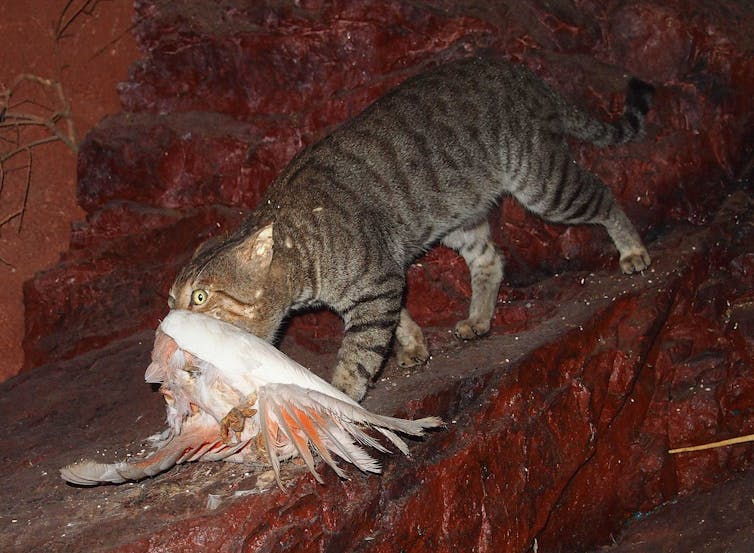 Feral cats were eradicated from just one island under the strategy.
Mark Marathon/Threatened Species Recovery Hub
Feral cats were eradicated from just one island under the strategy.
Mark Marathon/Threatened Species Recovery Hub
Priority species: how did we do?
The strategy met its target of ensuring recovery actions were underway for at least 50 threatened plant species and 60 ecological communities. It also made good headway into storing all Australia’s 1,400 threatened plant species in seed banks. This is good news.
The bad news is that, even with recovery actions, the population trajectories of most priority species failed to improve. For the 24 out of about 70 priority species where population numbers were deemed to have “improved” over five years, about 30% simply got worse at a slower rate than in the decade prior. This can hardly be deemed a success.
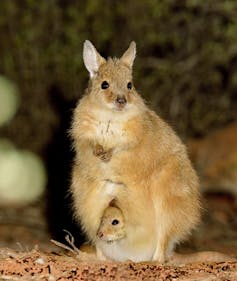 Populations of the mala, or Rufous Hare-wallaby, were improving before the strategy.
Wayne Lawler/Australian Wildlife Conservancy
Populations of the mala, or Rufous Hare-wallaby, were improving before the strategy.
Wayne Lawler/Australian Wildlife Conservancy
What’s more, the populations of at least eight priority species, including the eastern barred bandicoot, eastern bettong, Gilbert’s potoroo, mala, woylie, numbat and helmeted honeyeater, were increasing before the strategy began – and five of these deteriorated under the strategy.
The finding that more priority species recovery efforts failed than succeeded means either:
- the wrong actions were implemented
- the right actions were implemented but insufficient effort and funding were dedicated to recovery
- the trajectories of the species selected for action simply couldn’t be improved in a 5-year window.
All these problems are alarming but can be rectified. For example, the government’s new Threatened Species Strategy[19], released in May, contains a more evidence-based process for determining priority species.
For some species, it’s unclear whether success can be attributed to the strategy. Some species with improved trajectories, such as the helmeted honeyeater, would likely have improved regardless, thanks to many years[20] of community and other organisation’s conservation efforts before the strategy began.
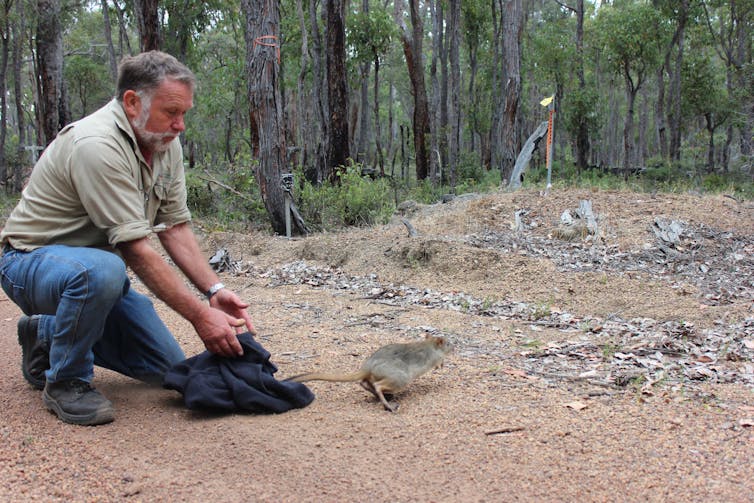 The improved outlook for some species is due to conservation efforts before the federal strategy.
WA Department of Environment and Conservation
The improved outlook for some species is due to conservation efforts before the federal strategy.
WA Department of Environment and Conservation
Read more: Australia-first research reveals staggering loss of threatened plants over 20 years[21]
What must change
According to the report, habitat loss is a key threat to more than half the 71 priority species in the strategy. But the strategy does not directly address habitat loss or climate change[22], saying other government policies are addressing those threats.
We believe habitat loss[23] and climate change[24] must be addressed immediately.
Of the priority bird species threatened by land clearing and fragmentation, the trajectory of most – including the swift parrot and malleefowl – did not improve under the five years of the strategy. For several, such as the Australasian bittern and regent honeyeater, the trajectory worsened.
Preventing and reversing habitat loss will take years of dedicated restoration, stronger legislation[25] and enforcement. It also requires community engagement, because much threatened species habitat is on private properties.
Effective conservation also requires raising public awareness of the dire predicament of Australia’s 1,900-plus threatened species and ecological communities[26]. But successive governments have sought to sugarcoat our failings over many decades.
Bushfires and other extreme events hampered the strategy’s recovery efforts. But climate change means such events are likely to worsen[27]. The risks of failure should form part of conservation planning – and of course, Australia requires an effective plan for emissions reduction[28].
The strategy helped increase awareness of the plight our unique species face. Dedicated community groups[29] had already spent years volunteering to monitor and recover populations, and the strategy helped fund some of these actions.
However, proper investment in conservation[30] – such as actions to reduce threats, and establish and maintain protected areas – is urgently needed. The strategy is merely one step on the long and challenging road to conserving Australia’s precious species and ecosystems.
Read more: 'Existential threat to our survival': see the 19 Australian ecosystems already collapsing[31]
References
- ^ abysmal conservation record (theconversation.com)
- ^ Threatened Species Strategy (www.environment.gov.au)
- ^ final report (www.environment.gov.au)
- ^ threats (www.preprints.org)
- ^ land clearing (www.theguardian.com)
- ^ wildlife and ecosystems (www.publish.csiro.au)
- ^ better managed (onlinelibrary.wiley.com)
- ^ 2 million goal (theconversation.com)
- ^ lack of systematic data (rmitconservationscience.files.wordpress.com)
- ^ other sources (www.feralscan.org.au)
- ^ One cat, one year, 110 native animals: lock up your pet, it's a killing machine (theconversation.com)
- ^ 2.1 million and 6.3 million (www.sciencedirect.com)
- ^ began in 2014 (link.springer.com)
- ^ primarily funded (www.mediastatements.wa.gov.au)
- ^ industry (gorgon-ncb.org.au)
- ^ offset (www.theguardian.com)
- ^ vital lifeline (www.publish.csiro.au)
- ^ wildlife species (www.nature.com)
- ^ new Threatened Species Strategy (theconversation.com)
- ^ many years (www.helmetedhoneyeater.org.au)
- ^ Australia-first research reveals staggering loss of threatened plants over 20 years (theconversation.com)
- ^ climate change (theconversation.com)
- ^ habitat loss (theconversation.com)
- ^ climate change (theconversation.com)
- ^ stronger legislation (theconversation.com)
- ^ 1,900-plus threatened species and ecological communities (www.environment.gov.au)
- ^ worsen (www.climatecouncil.org.au)
- ^ effective plan for emissions reduction (www.theguardian.com)
- ^ Dedicated community groups (www.potoroo.org)
- ^ investment in conservation (www.theguardian.com)
- ^ 'Existential threat to our survival': see the 19 Australian ecosystems already collapsing (theconversation.com)

















